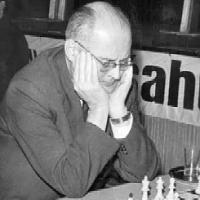
Pircs and Ponziani Schemes
The hypermodern Pirc Defense, which begins
1. e4 d6
2. d4 Nf6
3. Nc3 g6
is named after the Slovenian player Vasja Pirc, who was born in Idrija on December 19, 1907. Pirc had both victory and defeat in the Slovenian capital city of Ljubljana. His victory came in 1930 when he defeated Alekhine in this blitz game, which usually accompanies any discussion of Pirc.
His defeat, however, overshadowed this victory since it was in Ljubljana where he died on June 2, 1980.
Pirc, whose name is pronounced ‘peerts’ rather than ‘perk’, became an International Grandmaster in 1953 and played for Yugoslavia in no less than six Olympiads.

While Pirc did not invent the Pirc Defense which had been played by Paulsen in the 1880’s, he did revive it during the 1940’s and thus the opening often bears his name, though it is also known as the Antál or the Ufimtsev Defense. In any case, it is interesting to watch Pirc playing the Pirc in the following game against Radulescu.
Continuing our alphabetic journey of named openings, we come to yet another opening named after someone other than its originator. Ponziani’s Opening is played with the moves,
1. e4 e5
2. Nf3 Nc6
3. c3
While the opening is named after the Italian priest Domenico Lorenzo Ponziani (1719–1796), it was mentioned even earlier by Lucena and played by Staunton, though the opening is out of favor today.
Ponziani, who taught law in Modena, wrote an anonymous chess book in 1769 entitled Il Giuoco Incomparabile Degli Scacchi (The Incomparable Game of Chess). He should have attached his name to the book because 51 years later J. S. Bingham, an English naval officer, translated the book into English, but misattributed the original authorship to Domenico Ercole Del Rio, who was a contemporary of Ponziani. It is good that Ponziani did not live to witness this injustice, particularly in view of the embarrassing loss that Ponziani suffered to del Rio in this game.
Ponziani’s 2nd edition, to which he did finally append his name, is regarded as the best exposition of the Modenese school of play, and Ponziani discusses opening variations and strategy in more depth than elsewhere.

Note to the gentle reader: This blog is one of a continuing series that discusses the players whose names grace many openings. Here are the links to these blogs published to date:
The Names behind the Openings, Part 1
Caro, Kann and Chigorin – Openings Players

